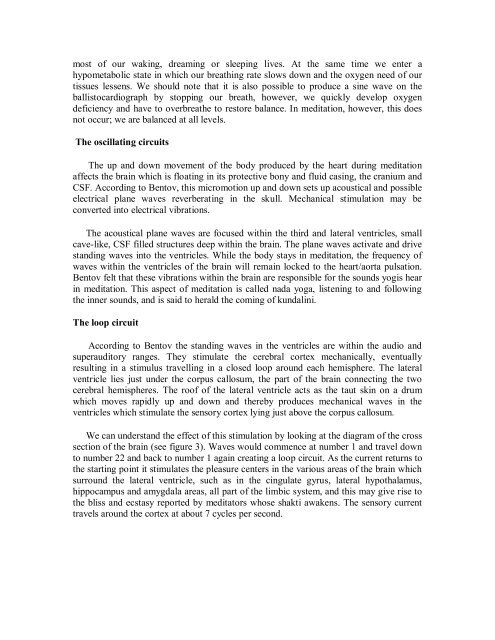Kundalini.Tantra.by.Satyananda.Saraswati
Create successful ePaper yourself
Turn your PDF publications into a flip-book with our unique Google optimized e-Paper software.
most of our waking, dreaming or sleeping lives. At the same time we enter a<br />
hypometabolic state in which our breathing rate slows down and the oxygen need of our<br />
tissues lessens. We should note that it is also possible to produce a sine wave on the<br />
ballistocardiograph <strong>by</strong> stopping our breath, however, we quickly develop oxygen<br />
deficiency and have to overbreathe to restore balance. In meditation, however, this does<br />
not occur; we are balanced at all levels.<br />
The oscillating circuits<br />
The up and down movement of the body produced <strong>by</strong> the heart during meditation<br />
affects the brain which is floating in its protective bony and fluid casing, the cranium and<br />
CSF. According to Bentov, this micromotion up and down sets up acoustical and possible<br />
electrical plane waves reverberating in the skull. Mechanical stimulation may be<br />
converted into electrical vibrations.<br />
The acoustical plane waves are focused within the third and lateral ventricles, small<br />
cave-like, CSF filled structures deep within the brain. The plane waves activate and drive<br />
standing waves into the ventricles. While the body stays in meditation, the frequency of<br />
waves within the ventricles of the brain will remain locked to the heart/aorta pulsation.<br />
Bentov felt that these vibrations within the brain are responsible for the sounds yogis hear<br />
in meditation. This aspect of meditation is called nada yoga, listening to and following<br />
the inner sounds, and is said to herald the coming of kundalini.<br />
The loop circuit<br />
According to Bentov the standing waves in the ventricles are within the audio and<br />
superauditory ranges. They stimulate the cerebral cortex mechanically, eventually<br />
resulting in a stimulus travelling in a closed loop around each hemisphere. The lateral<br />
ventricle lies just under the corpus callosum, the part of the brain connecting the two<br />
cerebral hemispheres. The roof of the lateral ventricle acts as the taut skin on a drum<br />
which moves rapidly up and down and there<strong>by</strong> produces mechanical waves in the<br />
ventricles which stimulate the sensory cortex lying just above the corpus callosum.<br />
We can understand the effect of this stimulation <strong>by</strong> looking at the diagram of the cross<br />
section of the brain (see figure 3). Waves would commence at number 1 and travel down<br />
to number 22 and back to number 1 again creating a loop circuit. As the current returns to<br />
the starting point it stimulates the pleasure centers in the various areas of the brain which<br />
surround the lateral ventricle, such as in the cingulate gyrus, lateral hypothalamus,<br />
hippocampus and amygdala areas, all part of the limbic system, and this may give rise to<br />
the bliss and ecstasy reported <strong>by</strong> meditators whose shakti awakens. The sensory current<br />
travels around the cortex at about 7 cycles per second.














![[Lonely Planet] Sri Lanka](https://img.yumpu.com/59845622/1/169x260/lonely-planet-sri-lanka.jpg?quality=85)


